Inari shrines are a type of shrine dedicated to the Japanese deity Inari. These shrines are immensely popular in Japan and can be found all around the country. It is estimated that a third of all the Shinto shrines in Japan are dedicated to Inari, who has more shines than any other deity in the Shinto pantheon. The most famous of these shrines is the Fushimi Inari-taisha. This particular shrine, which is located in Kyoto, is the Sohonsha, or “head shrine” of Inari shrines.
Although these shrines belong to Shinto, there are Buddhist temples dedicated to Inari. The most famous of these is the Toyokawa Inari, which is located in Aichi. This temple may be considered as the Buddhist counterpart of the Fushimi Inari-taisha. The Fushimi Inari-taisha and Toyokawa Inari, along with the Takekoma Inari Shrine are considered to be the three main shrines of Inari in Japan.
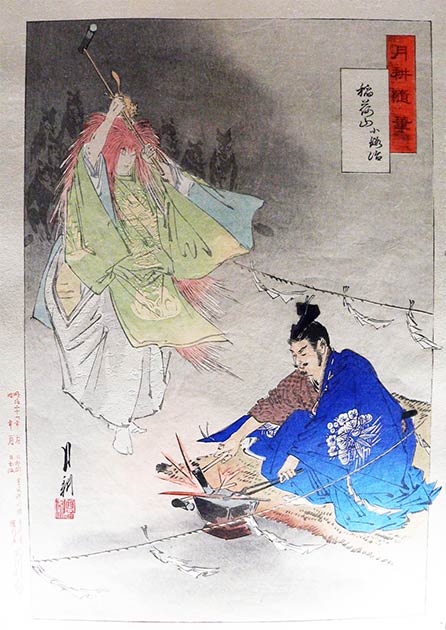
Inari Ōkami is a Shinto spirit, seen here helping a blacksmith. ( Public domain )
Who is the Great God Inari?
The full name of the deity is Inari Ōkami, meaning “the Great God Inari.” The name Inari itself is said to be a shortened form of Ine Nari or Ine ni Naru . This name is composed of two kanji words, the first meaning “rice” and the second meaning “cargo,” “freight,” or “to carry.” Whilst the first part of the name links the god with agriculture, the second connects Inari to trade. Another name, or rather title, of the god is Ta-no-Kami, meaning “God of the Paddy Fields,” which makes a clear connection between Inari and rice cultivation.
Despite being a major kami (a god or spirit) in Shinto, especially during the earlier period of Japan’s history, Inari’s exact origins are unclear. Nevertheless, it is widely believed that the worship of Inari already existed in Japan prior to the arrival of Buddhism during the 6 th century AD. This is due to the fact that when Buddhism arrived in the country, it quickly associated itself with the worship of Inari. At this point of time in Japanese history, Inari was closely connected with agriculture, in particular rice cultivation and tea. Since these contributed greatly to the Japanese economy during that period, Inari was also associated with success and prosperity. This in turn made the deity popular amongst merchants and tradesmen.
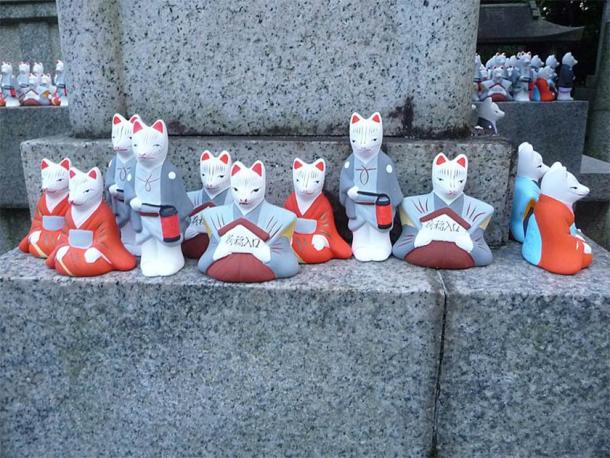
High demand of Inari fox statues are evidence of the popularity of the Shinto god Inari. (Immanuel Giel / CC BY-SA 4.0 )
Popular Deity: New Devotees Seek Inari’s Blessing
During the Tokugawa Shogunate / Edo period, significant changes occurred in Japan. Yet, Inari’s popularity as a deity did not wane. Instead, the god acquired new devotees. One of the groups of people who rose to prominence during this period were the smiths, due to the importance of the armor and weapons that they manufactured for the samurai class. As a consequence, Inari was adopted as the patron deity of blacksmiths and sword smiths.
Additionally, Inari was considered to be a protector of warriors. It was also during this period that Japan’s currency was transformed from a rice-based one to a gold-based one, further boosting the importance of those involved in the metal industry. This did not mean, however, that Inari became detached from the segment of Japanese society involved in agriculture. Instead, the deity was able to gain new worshippers, whilst maintaining its old ones.
The Tokugawa Shogunate came to an end in 1868, as a result of the Meiji Restoration. In the succeeding Meiji era, State Shinto was established and Inari, as a traditional kami, retained its popularity. Moreover, in the decades leading to WWII Japan rose as a global economic power and experienced the rise of capitalism and corporations. These factors served to further enhance Inari’s popularity. New companies, new corporate buildings, and corporations in general were dedicated to this deity.
In spite of the fact that State Shinto ended in 1945, following the end of WWII, Inari’s popularity continued. This is not entirely surprising, considering how the worship of this deity continued over the centuries despite multiple regime changes. Even today, Inari is still immensely popular in Japan. Corporations, for instance, still seek Inari’s blessings when starting an enterprise. The blessings of the deity are also sought for individual, communal, and national prosperity.

Inari Ōkami the fox goddess is perceived differently by different groups of worshippers, and is represented either as male, female or androgynous. ( Public domain )
Inari and Gender Fluidity
It is undeniable that Inari was, and still is an extremely popular deity in Japan. Due to this popularity, the deity came to be perceived differently by the diverse groups of worshippers acquired over the centuries. This was especially true during Japan’s pre-modern period, when religious beliefs were less uniform. This may serve to explain the gender fluidity of the deity, who is depicted either as male, female, or androgynous.
As an example, for Inari’s Buddhist followers, the deity is connected with the bodhisattvas, one who is on the path of becoming a Buddha. Each Buddhist sect also views the deity differently. For instance, in Shingon Buddhism the concept of dainikiten, or the divine feminine, is connected with Inari via foxes. For other worshippers, Inari is portrayed as a young female food goddess, and to others, as an elderly man carrying rice.
The most common representation of Inari is that of a fox spirit. ( KOSUKE / Adobe Stock)
Fox Spirit: Symbols Associated with Inari
Needless to say, there are also a multitude of symbols associated with Inari. The most common and recognizable of these is the kitsune, or fox spirit. Due to the deity’s association with these creatures, some even believe that Inari is in fact a kitsune. In any case, the kitsune is one of the best-known yokai, supernatural spirits or monsters in Japanese folklore. These are cunning female spirits who could either help or harm humans with their wiles. Since Inari is a benevolent deity, it is assumed that only the kitsune who use their abilities to help people are her true servants. These kitsune serve as the deity’s messengers and protectors.
This belief is expressed in the placement of fox statues outside many Inari shrines. This may be regarded as a variation of the practice of placing the komainu, a mythical creature in the form of a lion-dog at the entrances of shrines, so as to serve as their guardians. It has also been observed that whenever an Inari shrine has kitsune statues, the deity is almost always depicted as female. Additionally, it may be noted that these statues are often adorned with red votive bibs, and offerings of rice and sake are made to them.
Apart from the statues of the kitsune, there are a number of other common traits that make the Inari shrines easily recognizable. These include red roofs, white stucco walls, and the torii, a traditional Japanese gate that normally marks the entrance to a Shinto shrine. The last element is usually painted vermilion.
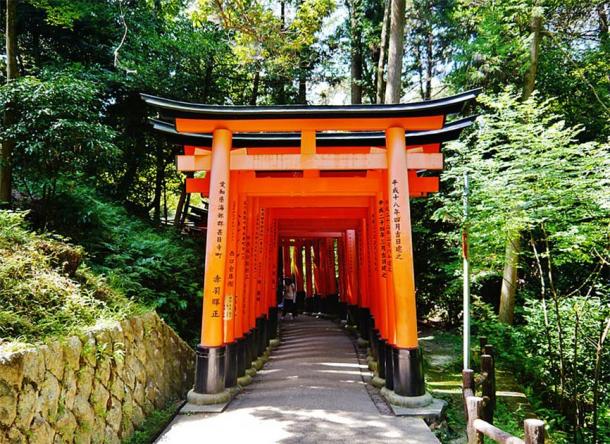
The Fushimi Inari-taisha Shrine in Kyoto is the most well known Inari shrine in Japan. Located in Kyoto it is most remembered for its Senbon Torii, one thousand vermillion red torii gateways. (Zairon / CC BY-SA 4.0 )
The Fushimi Inari-taisha Shrine in Kyoto
Some Inari shrines are marked by a single torii, whilst others have multiple torii arranged in a row. As mentioned earlier, the best-known Inari shrine is the Fushimi Inari-taisha, the “head shrine” of Inari shrines, in Kyoto. These various architectural elements can be seen at this important shrine, though it is perhaps most notable for its Senbon Torii , or “one thousand Torii.”
The Fushimi Inari-taisha is located at the foot of Mount Inari, in Fushimi-ku, a ward in the southwestern part of Kyoto. In addition to this main shrine, there are also a number of smaller sub-shrines, which are dotted around the sacred mountain. The earliest-known reference to the shrine can be found in the Yamashirokoku Fudoki . This is a report on provincial culture, geography, and oral tradition that was presented to the emperor, and dates to the early 8 th century AD.
According to one legend, a man by the name of Irogu no Hatanokimi shot a rice cake with an arrow, which transformed into a swan and flew away. The bird landed on the peak of a mountain, and rice miraculously started growing there. Irogu no Hatanokimi took this as an auspicious sign from the gods, and decided to call the sacred mountain Inari. According to another text, Irogu no Hatanokimi was ordered by Empress Genmei to enshrine three deities on three mountains on the first day of the Horse of the second month of 711 AD. It is assumed that one of these shrines was the Fushimi Inari-taisha. This would mean that the shrine is one of the oldest landmarks in Kyoto.
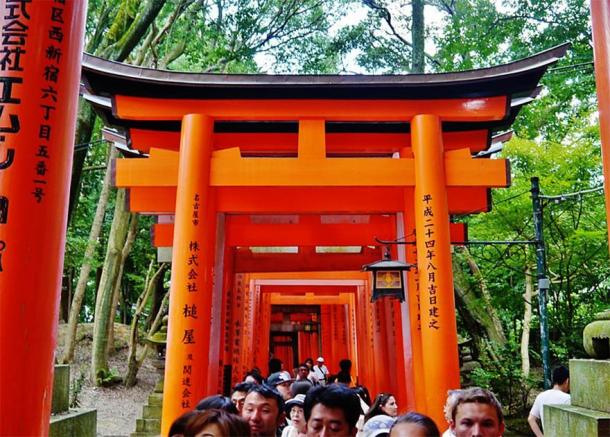
One thousand vermillion red torii gateways at the Fushimi Inari-taisha Shrine in Kyoto are arranged in such a way as to form a pair of parallel covered hiking trails. Each torii was donated either by an individual or a company. (Zairon / CC BY-SA 4.0 )
Although the Fushimi Inari-taisha originated in 711 AD, it was relocated to its present location in 816 AD. During the Heian period, which lasted from the end of the 8 th century AD to the end of the 12 th century, the shrine enjoyed imperial patronage. In 942 AD, for example, the shrine was elevated to the highest rank of Shinto shrines. In 1468, the shrine’s buildings were destroyed in a fire that was caused by a battle fought during the Onin War . It was only in 1499 that the min shrine structure was rebuilt. In 1589, the main gate of the shrine, the Romon (Tower) Gate, was constructed, thanks to donations from Toyotomi Hideyoshi , the de facto ruler of Japan at that time. In 1909, following the adoption of the National Treasure Preservation Law, the shrine was designated as a national treasure (today an Important Cultural Property).
As mentioned earlier, the Fushimi Inari-taisha is best-known for its Senbon Torii , which are located at the back of the shrine’s main grounds. It is due to these one thousand vermillion red torii gateways that many foreign tourists visit the shrine. They are arranged in such a way as to form a pair of parallel covered hiking trails. Each torii was donated either by an individual or a company, in the hopes that Inari would answer their prayers, or to thank the deity for answering those prayers. This practice is said to have originated during the time of the Tokugawa Shogunate. The price of the torii varies according to their size: the smaller ones costing around 400,000 yen, whilst the larger ones may cost up to a million yen. The donor’s name and the date of donation are inscribed on the back of each torii.
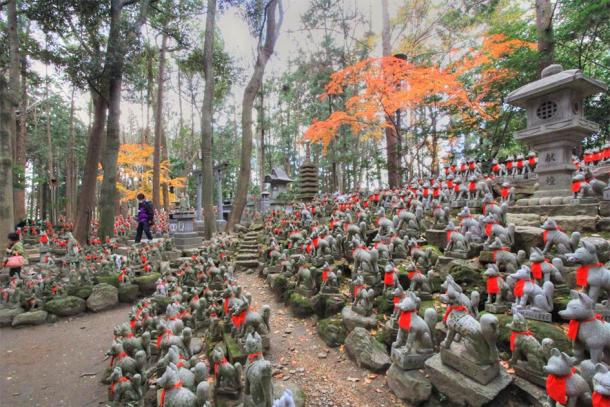
The Toyokawa Inari Shrine in Toyokawa is known for its Reiko-zuka, the hill of divine foxes, which contains about one thousand kitsune fox statues. ( くろふね / CC BY 3.0 )
The Toyokawa Inari Shrine in Toyokawa
Another major Inari shrine is the Toyokawa Inari in Toyokawa, a city in Aichi Prefecture. This Inari shrine is actually a temple belonging to the Buddhist Soto sect, a testament to the deity’s adoption by Buddhism and the religious syncretism that was occurring in Japan. Although popularly known as Toyokawa Inari, the temple is formally known as the Enpukuzan Toyokawa-kaku, Myogon-ji. The temple was founded in 1441 by Tokai Gieki, a Buddhist monk.
The primary deity of the temple is Toyokawa Daikini-shinten, a goddess with elements from both Buddhist and Shinto (more specifically Inari). According to legend, the third son of the Emperor Juntoku once had a vision in which Daikini-shinten appeared to him riding on a white fox, with a rice plant slung over his back. Inspired by this vision, the prince made a statue of the deity.
This statue, incidentally, found its way into the home of Ooka Tadasuke, a samurai who lived during the time of the Tokugawa Shogunate, and was later enshrined in the Toyokawa Inari Betsuin (in Tokyo) in 1887. Returning to the Toyokawa Inari in Toyokawa, one of the most notable attractions of this temple is the Reiko-zuka, or “Hill of Divine Foxes” where around one thousand kitsune statues are found. This hill may be considered as the equivalent of the Senbon Torii at the Fushimi Inari-taisha, as each was dedicated by a devotee whose prayers were fulfilled by Inari.
The third major Inari shrine is the Takekoma Inari Shrine in the city of Iwanuma, Miyagi Prefecture. Established in 842 AD, the shrine is the second oldest Inari shrine in Japan. Over the centuries, the shrine received the patronage of local rulers, including the Fujiwara clan of Hiraizumi, and the Date clan. Despite being the second oldest Inari shrine, the Takekoma Inari Shrine is not very well-known amongst tourists, and may be regarded as a hidden gem of the Tohoku region.
Inari has been, and still is, an extremely popular deity in Japan. This is evident in the fact that there are around 32,000 Inari shrines today. The deity’s popularity is also reflected in the fact that Inari was worshipped in both Shinto and Buddhism, and was adopted by various social classes over the course of Japanese history. Inari’s popularity is unsurprising, considering his/her association with success and prosperity. It is likely that that Inari will continue to be a well-loved deity for a long time to come.
Top image: The most famous Inari shrine is the Fushimi Inari-taisha, the “head shrine” of Inari shrines, in Kyoto. Source: f11photo / Adobe Stock
By Wu Mingren
References
ANA, 2020. “Toyokawa Inari” in ANA: Japan Travel Planner . Available at: https://www.ana.co.jp/en/sg/japan-travel-planner/aichi/0000010.html
Asano, J., 2017. “A Brief History of Fushimi Inari Taisha, Kyoto’s Most Important Shrine” in Culture Trip . Available at: https://theculturetrip.com/asia/japan/articles/a-brief-history-of-fushimi-inari-taisha-kyotos-most-important-shrine/
No name. 2020. “Fushimi Inari Taisha: History” in Fushimi Inari Taisha . Available at: http://inari.jp/en/history/
No name. 2020. “About Toyokawa Inari Betsuin (Akasaka,Tokyo)” in Toyokawa Inari Besuin . Available at: http://www.toyokawainari-tokyo.jp/english/
No name. 2020. “Fushimi Inari Shrine: The ultimate torii gate experience” in Japan-Guide-com. Available at: https://www.japan-guide.com/e/e3915.html
Japan National Tourism Organization, 2020. “Toyokawa Inari (Myogonji Temple)” in JNTO Website. Available at: https://www.japan.travel/en/spot/1216/
Kehoe, A.. 2019. “Takekoma Inari Shrine” in Japan Travel. Available at: https://en.japantravel.com/miyagi/takekoma-inari/8463
MATCHA. 2016. “Japanese Encyclopedia: Inari Jinja” in MATCHA. Available at: https://matcha-jp.com/en/1333
The Editors of Encyclopaedia Britannica. 2020. “Inari” in Britannica. Available at: https://www.britannica.com/topic/Inari
Tohoku Tourism Promotion Organization, 2020. “Takekoma Inari Shrine: One of Japan’s three great Inari Shrines and one of Miyagi’s symbols” in Travel to Tohoku . Available at: https://www.tohokukanko.jp/en/attractions/detail_1564.html
Wright, G., 2020. “Inari” in Mythopedia. Available at: https://mythopedia.com/japanese-mythology/gods/inari/
Related posts:
Views: 0
 RSS Feed
RSS Feed

















 November 14th, 2020
November 14th, 2020  Awake Goy
Awake Goy 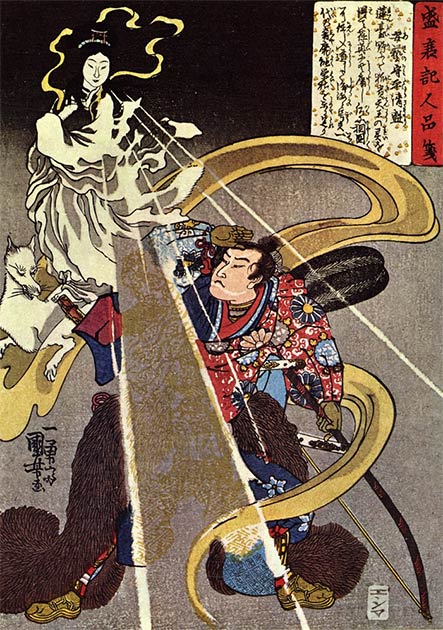
 Posted in
Posted in  Tags:
Tags: 
















